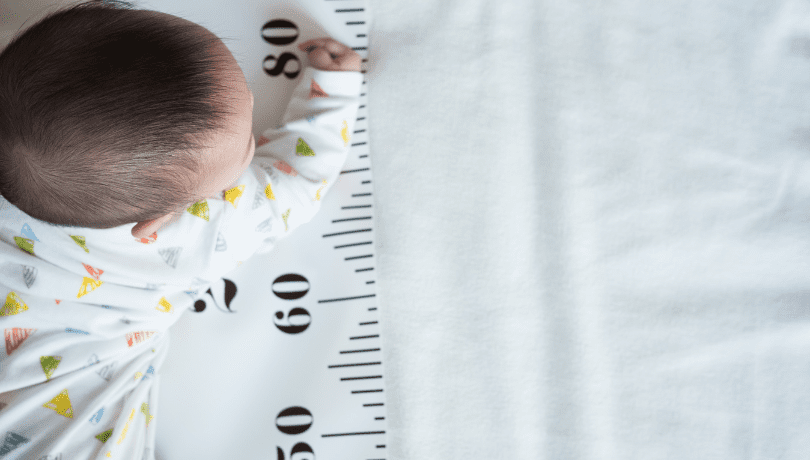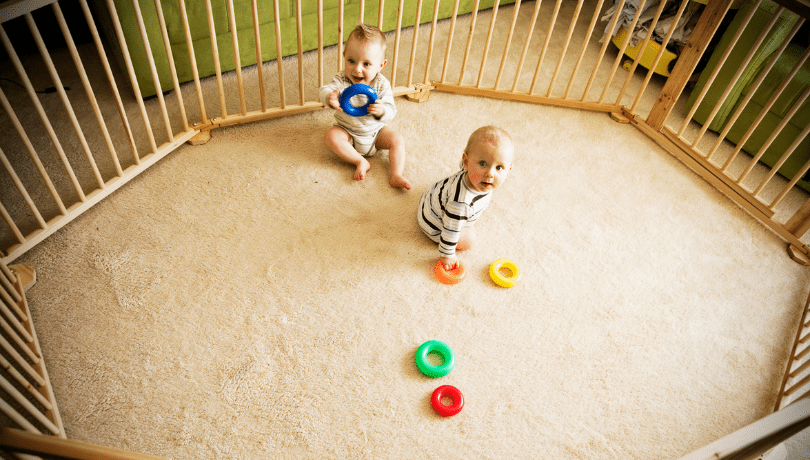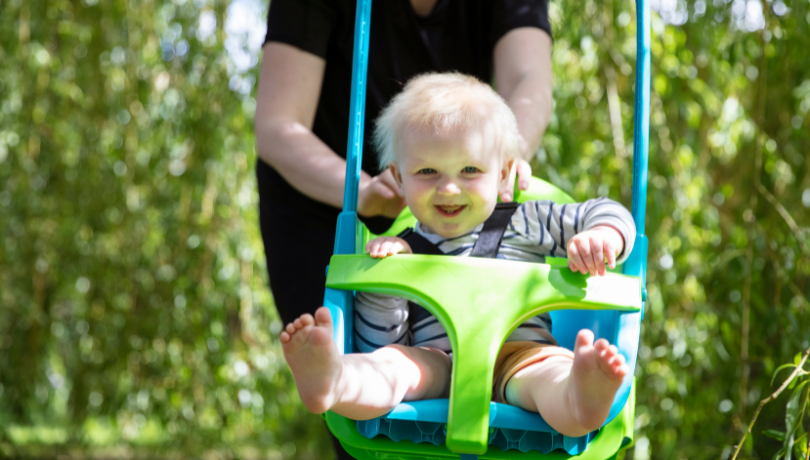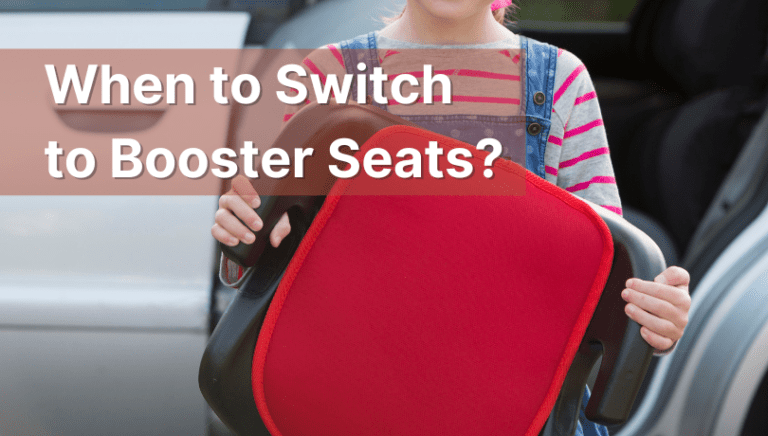When to Stop Using Baby Swings: An Informative Guide
A swing serves a purpose beyond simply providing convenience for parents or caregivers.
I remember putting Theo in his swing while I made breakfast. It was the most amazing sight – he’d look everywhere with his big eyes and smile at me now and then. Swings can be practical to have, especially during the fourth trimester (the first 12 weeks post-birth) when babies love to be wrapped and cuddled constantly.
My advice? Cherish this time for as long they let you because soon, you’ll have to think about when to stop using baby swings too.

And knowing when to transition your baby out of a swing need not be rocket science. It is the last stage of your little one’s swinging timeline. But if you move them out abruptly, it can be challenging for them.
Hence, I wanted to share my experience on how I transitioned my babies out of their swings.
Table of Contents
Time Limits: How Long Can a Baby Use a Swing?
15 to 20 minutes max!
That’s the time limit most experts recommend. And in one day, set the maximum limit to only one hour in the swing, broken into 15 to 20-minute intervals. Here are a few things to remember so you can blend baby swings with tummy time and floor time for a well-rounded experience:
As per AAP recommendations, let them enjoy tummy time as much as they can throughout the day. Gradually increase their tummy time as they grow.
- From day one home from the hospital, introduce brief tummy time sessions. Keep a close eye on them—safety first!
- Establish a routine for your little one to promote a calm household and foster independence. In addition to their time in containers like baby swings, include lots of floor time, independent play, and tummy time.
And another thing: never let them sleep in their baby swings!

Prevent Container Baby Syndrome!
The American Physical Therapy Association has coined the term ‘container baby syndrome’ (CBC), for babies who spend excessive time in baby devices like swings, bouncers, car seats, etc.
- Along with movement issues, delayed motor skill development, cognitive and speech delays, and socio-emotional delays, CBC can also cause positional plagiocephaly or flat spots.
- According to experts, even though the effects are temporary, delayed milestones can impact their confidence and independence. For instance, container babies find it difficult to learn self-care skills such as feeding, dressing themselves, etc.
When to Stop Using Baby Swings
“Until yours (kid) starts to move around a lot more, you will not know when the banishment of the swing will happen.”
Our pediatrician warned us about Aiden rolling over in the swing. Even with the tight straps that come in the swing, babies (obviously) insist on exploring. That’s why we transitioned my Aiden to a playpen at six months, but not all children go at the same pace! My youngest, Theo, took his sweet time in the swing.
Experts suggest that babies should be transitioned out of the swing as soon as they learn to sit independently or start trying to do so. At this stage, keeping them strapped in the swing can be dangerous.
They Lead, We Follow
It’s not just about hitting those milestones! Sometimes babies just want a change of scenery. They might tire of the swing and crave independent playtime in the pack-and-play or playpen.
- Check the weight limit on the swing – manufacturers often set a weight limit for each model. Whether you’re using a Graco, Mamaroo, or any other, most swings are suitable until your baby reaches 25 to 30 lbs.

- With some babies, you won’t get the choice to wait until they are six or nine months. Like my youngest daughter, they will refuse to be put in the swing or lunge at the edge. At this point, keeping them strapped in the swing can be dangerous.
- And, sometimes (rarely), babies can wiggle out of the swing if they are too bored. This can be dangerous since they can fall and injure themselves. Furthermore, if you have older kids or pets in the house, they can disturb the swing and injure your little one if you are not careful with it.
But hey, new parents! No rush to transition the baby from the swing. They lead; we follow. Babies set the pace!
Let ‘em Explore
Babies crave variety too! Imagine being stuck on a couch while people chatted at you—boring, right? Introduce diverse activities to ignite their curiosity and encourage exploration!
- In a baby-proofed room where you can interact with your little one, try floor time in a safe space like a playpen instead of confining your little one.
- Place them on their back and engage gently with babies younger than two months. Play games, sing, or just talk—they love your voice, and it improves listening skills!
My go-to tummy time game was the magic carpet at six months. Lay your little one on a clear, soft surface like a blanket or rug, then gently glide them around. It’s a fun way to explore and build core and arm strength!
Babies aren’t exempt! Like adults, prolonged sitting harms infant growth. So, let ‘em explore.
You might also like: Is It Worth Getting a Baby Swing?
When Do Babies Outgrow Swings?
Babies are busy little bees. In the first year, they do a lot of growing. Some days, it seems like they’d outgrow their clothes and devices in just a blink (They do).
Even though the transition period is subjective to individual growth, developmental milestones, and personality, most babies outgrow the swing around six to nine months. However, if your baby particularly dislikes the swing or wants to explore on their own, they may reject the swing way before that.
Look at what this new mom had to say about it,
“We’re at 5 months and while I still have it out, we rarely use it. She would rather practice her rolling on the floor or spend time in her jumper.”
If you’re still confused about when babies outgrow their swings, look for these signs:
- Your little one is reaching up to grab the toys or the mobile attached to the swing.
- Baby is starting to roll over and trying the same in the swing, despite the swaddle and straps.
- The infant is crying constantly in the swing and wants to spend more independent time on the play mat.
- Your baby’s weight isn’t compatible with the swing’s weight limit—most swings allow babies to use one only until they are 25 to 30 lbs.
- You’ve found the little peanut on the floor, even after carefully buckling them in the swing (Hint: They’re too big for their swing).
I’ve also written another post on how to use baby swings if you’re interested.
What Do I Do Now?
If your kid signals that they’ve outgrown the swing, don’t fret. It’s an exciting time for both your baby and you. They’re just starting to explore the world, so, find the right devices and routines to support and encourage their curiosity. Here are other play tools you can consider:
Playpens
You don’t have to switch to another swing if your baby has outgrown it. Consider a playpen—it’s a safer option without the risks.

- The high guard rails ensure they can’t climb up, and wander off when you’re not looking.
- Unlike a swing, your baby can safely fall asleep or nap in the playpens.
- It also encourages independent play, developmental milestones, hand-eye coordination, cognitive development, etc.
- And good news for the parents: Unlike a swing, playpens are portable, easy to store, and travel-friendly.
Bucket Swings
Kids absolutely adore bucket swings. You’ll be hard-pressed to find a kid who isn’t smiling ear-to-ear when in that swing.

But it’s different for every kid. Some parents wait until they are a little older, i.e. 18 months, before putting them in the swing. Others let their kids enjoy the swing when they develop consistent head and trunk control. Once your baby can sit straight unassisted, they can go on this swing safely.
- Outdoor bucket swings encourage social interaction, confidence, and the development of social skills.
- Bucket swings are also good for the baby’s balance and core muscle development.
- Swinging is an excellent physical activity, plus it’s where your kid will make their first friend.
- For developmentally challenged kids, swinging can improve spatial awareness and inner ear balance. It stimulates the brain for further complex development.
Whenever you decide to put your little one in the bucket swing, remember,
“Little pushes at first. And if I had something, I would usually stuff a blanket or jacket behind them to help them stabilize.”
Wrapping Up: Know When They Are Ready to Transition
Parenting is a mix of beauty and overwhelm, don’t you think? Seeing other kids breeze through milestones while yours takes their time can be tough. But remember, as long as your baby is happy and healthy, you’re doing it right.
When transitioning your little one from baby swings, watch for those signs we talked about earlier. Remember, infants and toddlers never suffer in silence; if they’re uncomfortable in the swing, they’ll let you know. Stay patient, keep an eye on age and weight limits, and most importantly, enjoy every moment.
The secret to parenting? Simply love, understand, and care for your little one with all your heart.






